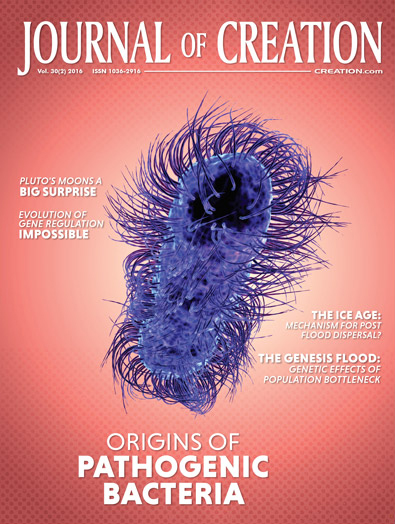Journal of Creation 30(2):11–12, August 2016
Browse our latest digital issue Subscribe
The origin of meteorite chondrules

Meteorites are claimed by secular scientists to be the rocky debris left over after the formation of the solar system. Chondrites, stone meteorites, represent 85% of the rocks that fall on the earth; the remaining 15% mostly are iron meteorites. Uniformitarian scientists believe the inner four rocky planets of the solar system, including the earth, were formed largely or totally of chondritic rock. That is one reason for the intense study of chondrites.
Naturalistic origin of chondrites not even in sight
There are a number of problems with the secular understanding of the origin of chondrites. First, they cannot be observed forming today. Therefore, all ideas on the origin of chondrites go against the uniformitarian principle of ‘the present is the key to the past’. This is also true of all other ideas of origins in the solar system and universe.1,2 Of course the researchers claim conditions were unique 4.5 billion years ago, so that solar system formation just happened to form.3 But even with the special ‘back then’ conditions, there are other problems.
A second issue is the temperature necessary for meteorite and/or planet formation.
“But meteoriticists have been hard pressed to come up with enough energy even then to rapidly heat rocky dust to 1600 kelvin or more and melt it into globules. The nebula at the time was merely warm—at most several hundred kelvin.”3
Globules need to be melted in order to form chondrites. One researcher was able to come up with 14 heating mechanisms for dust, which brings up a second problem, that such ideas cannot be tested:
“None [of the 14 heating mechanisms], Rubin noted, struck astrophysicists as particularly plausible. … ‘There are a lot of models out there, but I’m not sure how you can really test them … .’”3
Evolutionary scientists have a number of hypotheses, but they need to consider whether their ideas make sense and whether they can be tested.
A third problem is the origin of chondrules within chondrites, the melted globules, which range in size from a few micrometres to a centimetre (figure 1). Chondrules are composed mostly of the silicate minerals olivine and pyroxene, thought to be common mantle rocks of the earth, embedded in a smooth matrix. Chondrules
“… form as molten or partially molten droplets in space before being accreted to their parent asteroids. … Chondrules are believed to have formed by a rapid (flash) heating (within minutes or less) and melting of solid dust aggregates of approximately Solar composition under temperatures of about 1000 K.” 4
So, chondrules are believed to have been rapidly heated, anywhere from 1,000 to 1,600 K, and became molten before incorporation into its parent asteroid. Some chondrules have textures that show rapid cooling from a molten mass. Needless to say, such processes are beyond experimentation and testing.
An analysis of the chemistry, rock types, and isotopes reveals additional problems. Chondrules are quite diverse with four groups and 12 subgroups. There is no ‘normal’ type of chondrule, making it virtually impossible to come up with a uniform origin model. They have also retained their ‘volatiles’. Volatiles are those elements or minerals that are more easily vapourized. Why should chondrules contain volatiles if they melt at hot temperatures? Moreover, researchers conclude that some chondrules must have been ‘remelted’ or partially ‘remelted’.
Because of the huge challenges for a naturalistic origin for chondrules, the origin of chondrites is a major mystery for astronomical science:
“Blobs called chondrules in the fabric of rocks from space have long baffled scientists. A new idea may shed light on their origins, but some experts have given up hope. … How would you like your decades of research on a field’s central problem to be summed up by the statement that ‘these objects remain as enigmatic as ever?’”3
These challenges are better explained by God creating the solar system in a very short time, as described in Genesis.
References and notes
- Psarris, S., What You Aren’t Being Told About Astronomy, vol. 1: Our Created Solar System, Creation Astronomy Media (DVD), 2009. Return to text.
- Psarris, S., What You Aren’t Being Told About Astronomy, vol. 2: Our Created Stars and Galaxies, Creation Astronomy Media (DVD), 2011. Return to text.
- Kerr, R.A., Meteorite mystery edges closer to an answer—or the end of a field, Science 341:126–127, 2013. Return to text.
- en.wikipedia.org/wiki/Chondrule, accessed 10 November 2014. Return to text.








Readers’ comments
Comments are automatically closed 14 days after publication.